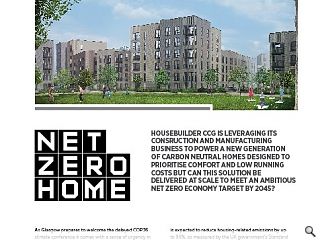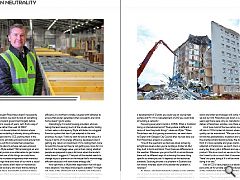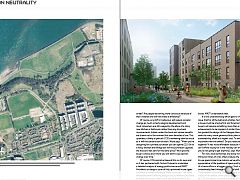Carbn Neutral Homes: Net Zero
21 Apr 2021
Housebuilder CCG is leveraging its construction and manufacturing business to power a new generation of carbon neutral homes designed to prioritise comfort and low running costs but can this solution be delivered at scale to meet an ambitious net zero economy target by 2045?
As Glasgow prepares to welcome the delayed COP26 climate conference it comes with a sense of urgency in dealing with that other great crisis of our times, excess carbon production. As one of the biggest sources of pollution, construction has long been part of the problem but as a new breed of energy-efficient designs come to market it could soon be part of the solution In the vanguard of efforts to deliver change is timber construction and off-site manufacturing specialist CCG, which has launched a new housing standard that aims not just to reduce but to eliminate carbon emissions by swapping highly polluting gas for solar panels, battery storage and air/ground-source heat pumps. This pivot to renewables combined with thermally modelled construction is expected to reduce housing-related emissions by up to 98%, as measured by the UK government’s Standard Assessment Procedure for calculating energy efficiency.
Dubbed the Net Zero Home standard this pioneering design is described as being as efficient as it is cost-effective and it is poised for a mass-market rollout at pace, commencing this May when North Lanarkshire Council breaks ground on a 19 home pilot project at the site of three demolished tower blocks at Holehills, Airdrie. That will be followed by a 444-home development at Granton Waterfront called Western Villages and a private housing development on Edinburgh Road, Glasgow. Talking Urban Realm through the new approach CCG managing director David Wylie said:”18 months ago we took a step back and thought Passivhaus doesn’t necessarily give you net-zero carbon, we want to look at something different and work toward government targets before getting rid of gas in a couple of years. Let’s find a way of achieving that now rather than wait till 2024.”
Armed with an in-house timber kit division whose heavy-duty thermal modelling is already driving efficiency has given a vital head start to CCG, putting them in the vanguard of efforts to eliminate emissions and ensure that the only hot air you will find is inside their properties. Asked how CCG plans to achieve net-zero emission targets in practice Wylie added: “We’re looking at air and ground source heat pumps as an alternative to gas boilers. We’re conscious that one of the things we could have done was to try and increase airtightness even more but we’re already at a high level and most of our work is social housing. A lot of our clients aren’t keen on mechanical ventilation and heat recovery and knew that by taking it down further, while there are benefits in terms of space heating, it would give them an issue in terms of capital and running costs.” Another easy win was in maximising the area of roof space given over to photovoltaic panels, essential for efficiency in a northern climate, coupled with batteries to ensure that power generated when occupants are not at home doesn’t go to waste. Interestingly it is social housing providers who are taking the lead, leaving much of the private sector trailing in their wake, a discrepancy Wylie attributes to a sluggish financial system that hasn’t yet adapted to the new priorities.
He says: “Until we start to look at the value of a house in terms of its energy efficiency developers aren’t getting any return on investment. If it’s costing them more to build this house but they’re not getting any more for it in terms of the mortgage value, you’re then risking whether people are prepared to pay a bit more when the lender’s value doesn’t suggest it. That part of the market needs to change to put a premium on the house that’s more energy efficient because it will have lower energy bills.” How optimistic is Wylie that steps taken now will spur mass adoption? Are these trial projects scalable? “It might not come in the short term but it certainly will in the long term because of the government’s commitment to reduce CO2 emissions. As soon as boilers get kiboshed people are going to have to look at alternatives and those will naturally lead you towards a carbon-neutral offering. If it’s a development of 12 plots you could use air source heat pumps and PV. If it’s a development of 200 you could look at building a network.” Focussing everyone’s minds is COP26. What is Scotland doing in international terms?
“Everywhere is different in terms of how they build things”, observes Wylie. “When Passivhaus was first gaining momentum, we went down to Exeter with Glasgow City Council after we had done our first Passivhaus project in Lockerbie. “One of the questions we had was about achieving airtightness levels when you’re building a timber kit. But they built in brick and block. Then there are differences in the weather. Wherever you go in the UK or across Europe there will be different ways of achieving the same thing specific to where you are. It depends on the resources available. Sourcing brickies is a problem in Scotland but not timber whereas south of the border the problem is reversed.” As always, one factor hindering uptake is cost, with the use of ground-source heat pumps still proving to be cost-prohibitive in many cases but Wylie is confident that this is only a temporary issue.
“When more and more people start using air and ground source heat pumps the cost will come down and other technologies will come in”, he says. “When we did our first Passivhaus job down in Lockerbie eight years ago there were only six manufacturers who could deliver a Passivhaus window, now there are over 50.” As of now most of the low carbon magic takes place off-site in CCG’s timber kit division where tight control of quality can be maintained. “We use a closed panel timber kit that has plasterboard, insulation and windows doors to the oriented strand board outside. We did that because we think it’s more versatile and gives clients options. We’re not a Barratt or Persimmon, we don’t churn out the same thing every day. Every job is different and we need a versatile product. We do as much as we can in the factory but we don’t want to do so much that it becomes cost-prohibitive. There’s no point doing it if it will be more expensive than doing it on-site.” One of CCG’s next projects is a development of 180 net-zero units, all for private sale at Edinburgh Road, Glasgow, as the contractor tests market readiness with the support of low carbon funding from the Scottish Government. Wylie continues: “The funding wouldn’t cover the full cost but we want to test the market. Mortgage lenders might not do anything but will it be an easier sell for Joe Bloggs on the street? Are people becoming more conscious because of their children and will that make a difference?” Of course, any shift in behaviour will require societal change as much as technological development and most consumers are still swayed by the allure of a shiny new kitchen or bathroom rather than any structural improvements hidden under the hood and whose benefits are drawn not in the moment but over decades of use.
This quandary is likely to perturb CCG’s marketing team as much as it will the construction division. Wylie says: “When you’re designing for a private purchaser you can spend £2.5-5k on a fancy kitchen and fittings but will the purchaser upgrade the house to net zero for the same price? We’ll give the buyer a choice and I think you will start to see opinion change over time.” Of course, CCG cannot achieve all this on its own and so it has partnered with Carbon Futures to undertake a detailed analysis of energy performance and MAST Architects to design a suite of fully optimised house types on which to model the theory.
Wylie continues: “We need affordable award-winning designs and sometimes you have to make the choice, clients can’t pay for everything, we need to strike the right balance and not end up with square boxes. MAST understands that. It is this understanding which gets to the heart of the issue, that for all the bells and whistles, facts and figures a house must be a home first and foremost and most buyers will require something more than a list of technical achievements to be inspired. A similar thought process has guided the design of the Glasgow House, which seeks to marry more generous floor plans with enhanced sustainability, albeit at a higher cost.“
Is one factor more important than the others? Do you raise standards together? "It has to be affordable because if the government can’t afford to pay for it and nobody can afford to do it then you’re not going to get anything”, says Wylie. For now, local authorities are doing most of the heavy lifting but times of crisis often produce the greatest change. As we spend more time indoors we’ve all become acutely appreciative of the qualities of space and light, be it that of a home office or a bigger garden. Such sentiments will undoubtedly feed through to a modal shift in the market. The pressure is building. We’re not there yet but the first cracks in the edifice of the status quo are beginning to show as CCG and others continue to enlarge our notions of what is possible.
|
|





